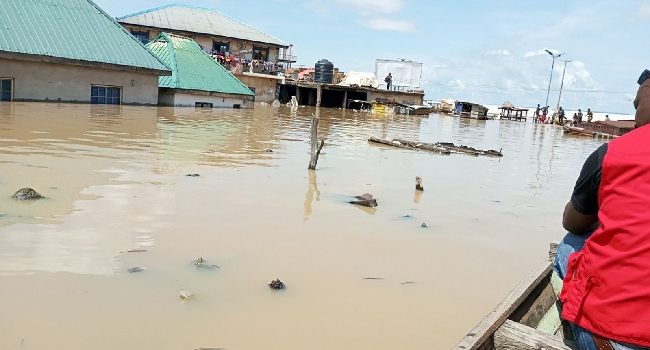News
REVIEW: Another flood disaster looms, as states fail to act months after Lagdo Dam crisis

Over seven months after the opening of the Lagdo Dam in Cameroon on September 13, 2022, which displaced many Nigerians, especially across the North-Central regions, many state governments In Nigeria are yet to institute proactive means towards curbing future occurrences.
With the rainfall witnessed in Nigeria in 2022, coupled with the opening of the dam, over 100,000 Nigerians have been displaced, at least 300 killed and more than 500,000 others affected in the past few months.
According to the National Emergency Management Agency (NEMA), over 1.4 million people have been displaced due to the floods as of 24 October.
Over 569,000 hectares of farmland were destroyed or damaged by floods ahead of the October harvest season and may aggravate already alarming food insecurity.
Data released by the National Emergency Management Agency and the Nigeria Hydrological Services Agency, at an emergency technical meeting, in Abuja, on the flood situation across the country disclosed this.
“Based on our communication with NIHSA, the Lagdo Dam operators in the Republic of Cameroon, had commenced the release of excess water from the reservoir on September 13, 2022,” the Director-General, NEMA, Mustapha Ahmed, stated while speaking at the meeting.
He added, “We are aware that the released water cascades down into Nigeria, through River Benue and its tributaries, thereby overwhelming communities that have already been impacted by heavy rainfall.
“The released water complicates the situation further downstream, as Nigeria’s inland reservoirs including Kainji, Jebba and Shiroro, are also expected to overflow between now and October ending.
“According to NIHSA, Kainji and Jebba dams have already started spilling exess water from their reservoirs. This will have serious consequences on frontline states and communities along the courses of rivers Niger and Benue.”
Ahmed outlined the states that are most likely to be affected as; Adamawa, Taraba, Benue, Niger, Nasarawa, Kebbi and Kogi states.
He also said that some Niger-Delta states including Edo, Delta, Anambra, Cross-River, Rivers and Bayelsa, were expected to record heavy floods due to the above normal rains, coupled with the combined waters of rivers Niger and Benue, as they empty into the region.
States’ Eerie Silence
Meanwhile, the state governments have been eerily silent over instituting solutions towards tackling these annual floods while ensuring a no-repeat of the Lagdo Dam havoc.
This came as the NEMA, on Sunday, March 4, issued a warning of upcoming severe flooding this year as indicated by predictions from relevant agencies.
The NEMA Director-General, Mustapha Ahmed, in a statement, noted this had earlier been revealed in the seasonal climate predictions and annual flood outlooks by the Nigerian Meteorological Agency and the Nigeria Hydrological Services Agency.
Ahmad disclosed this at a two-day Experts’ Technical Meeting on 2023 Climate-Related Disaster Preparedness and Mitigation Strategies in Abuja.
He said, “The flood disaster in 2022 was an eye-opener. However, the agency would spread early warning messages to states and local government areas and the Federal Capital Territory.
“We have started early this year, as we are ready for early warning and early action. We will bombard every citizen, state and local government with this information as we want them to know that it is serious and we will not keep quiet, because we want them to know that there will be flood this year.”
In the same vein, the Director-General of Nigeria Hydrological Services Agency, Clement Nze, disclosed that 178 LGAs in 32 states and the FCT had been predicted to experience severe flooding in 2023.
He said, “This time, we came out early with this prediction and we expect that relevant actors, governments, and individuals will go to work. We expect that actions should be taken, especially at the sub-national levels, early enough, to mitigate the impact of flooding in the country.”
The tragedy that occurred nationwide in 2022 as a result of the terrible floods revealed the vulnerability of the nation once more. It demonstrated that as a nation, Nigeria can no longer treat environmental issues and other human security concerns with kid gloves if the discharge of water from a single dam in a neighboring country can have such a serious influence on its stability.
This national tragedy was foreseen for a long time, but state actors did nothing to stop it beyond issuing weather forecasts and warnings about impending rainfall.
The lack of concern shown by governments at all levels for the flooding problem defies all sensibilities. It is disappointing that the country is still sluggish in its search for a long-term solution to a national and security challenge of this magnitude, ten years after the terrible effects of the 2012 flood.
Experts lament that the displayed laxity dramatizes Nigeria’s pervasive culture of bad governance and leaders’ incapacity to confront pressing global issues. They contend that the onus is on the leadership to shelve politicking and tackle the issue before a repeat of 2012 and 2022 happens.
Join the conversation
Support Ripples Nigeria, hold up solutions journalism
Balanced, fearless journalism driven by data comes at huge financial costs.
As a media platform, we hold leadership accountable and will not trade the right to press freedom and free speech for a piece of cake.
If you like what we do, and are ready to uphold solutions journalism, kindly donate to the Ripples Nigeria cause.
Your support would help to ensure that citizens and institutions continue to have free access to credible and reliable information for societal development.
























